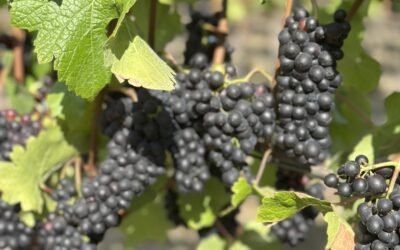
Grape vines in a Connecticut vineyard.
History of Connecticut Wine Industry
Haight Brown Vineyard in Litchfield, Connecticut, was the state’s first commercial winery, established in 1975 by Sherman Haight. Haight worked with the University of Connecticut and Cornell University to grow the state’s first Vitis Vinifera grapes, Chardonnay and Riesling. In 1976 he built a winery high on a hill and the surrounding vineyards became Haight Vineyard, renamed Haight Brown in 2007 by the new owners. The winery closed in 2023, but its founder holds an important place in the production of wine in Connecticut. In 1978, Haight petitioned the state to pass legislation recognizing farm wineries, which resulted in the Farm Winery Act. The purpose of the legislation was to allow Connecticut farm wineries to produce wine, sell it at retail, and distribute it to retail shops and restaurants.
Haight was not Connecticut’s only wine pioneer in the late 70’s. In 1978, Dr. Paul DiGrazia, an accomplished and well-respected medical doctor, planted 45 acres of grapes in Brookfield, Connecticut, and established DiGrazia Vineyards. The winery opened for commercial sales in 1984, with an initial release of four brands of wine. In 1979 Bill and Judith Hopkins converted their 225 year old dairy farm into a vineyard and along with Haight and DiGrazia became one of the first wineries in the now thriving Connecticut wine industry. Hopkins Vineyard, a now fourth generation family run winery, has consistently produced award-winning whites, reds, and sparkling wines.

Wine glass in the vineyard. Photo by Elle Hughes via Pexels.
Growth of the Connecticut Wine Industry
In the 1980s, as the number of wineries in Connecticut grew, they formed the non-profit Connecticut Vineyard and Wine Association (CVWA). The association aimed to support each other and the new Connecticut wine industry through promotion, education, and legislation advocacy. In 1988, they conceived the idea of a Connecticut Wine Trail, a driving route linking CVWA member wineries across the state, and it opened in 1992 with five wineries. In 2008, to further expand the promotion of wine, the Passport to Connecticut Wine Country, sponsored by Connecticut Farm Wineries and the Connecticut Department of Agriculture, was created.
The Passport program features 38 participating farm winery locations and visitors collect a stamp when tasting either in a “passport” book or on the virtual APP. All the farm wineries listed in the Passport to CT Wine Country app or book are licensed farm wineries using at least 25% Connecticut Grown products in their wines. Businesses must apply to participate and meet the eligibility criteria. Locals and visitors can use the app to navigate through CT Wine Country to seek new experiences and taste unique products.

Green grapes hanging on a branch. Photo by Bo Zhu via Pexels.
Styles of Wine Produced in Connecticut
Connecticut wineries are located throughout the state and have three federally designated American Viticultural Areas (AVA). The climate and kind of grapes grown varies depending on where in the state a winery is located. The coastal regions near Long Island Sound and the Connecticut River valley tend to be warmer, allowing Merlot and Cabernet Franc to thrive. The highlands in the eastern and western sides of the state have cooler temperatures due to elevation and are best suited for cool-climate grapes like Pinot Noir and Riesling. French hybrid grapes such as Vidal Blanc, Chambourcin, and Marechal Foch have grown successfully in the region. They are used by wineries, along with several Native American grapes, to produce wines of varying styles.
To learn more about Connecticut’s award-winning wineries, plan a trip along one of the three Wine Trails, and get the official CT Wine Passport app, visit the CT Wine Trail website. Many of the wineries offer food, music, and event space for weddings.
This article was originally written for Recette Magazine, and was published online on March 19, 2021. See the original article here: https://blog.suvie.com/a-beginners-guide-to-connecticut-wine. See all of the Fifty States of Wine articles here: https://alwayssharingwine.com/category/asw-blog/fifty-states-of-wine. See all of Susan’s previously published articles here: https://alwayssharingwine.com/tag/previously-published.



